This presentation describes an experience of mapping a geological structure with a commercial UAV (Unmanned Aerial Vehicle).
Being based in Venezuela, an appropriate area for the acquisition was identified in the Andes Cordillera where a major strike slip fault (Boconó Fault) intersects geomorphic features modeled by the latest glaciation.
This fault is a major tectonic lineament oriented SW-NE, extending more than 300 km along the Venezuelan Andes and accommodating a dextral slip on the order of 1 cm/year.
This motion has displaced various landscape features that cross the fault, in particularly the "Los Zerpa" moraine system, located a few kilometers NE of the locality "Apartaderos".
The moraine formed during the last glaciation that ended 10,000 years ago; its northern tip crosses the Boconó Fault and is displaced 100 m towards the NE; this corresponds to a rate of 1 cm/year, which is consistent with GPS measurements.


